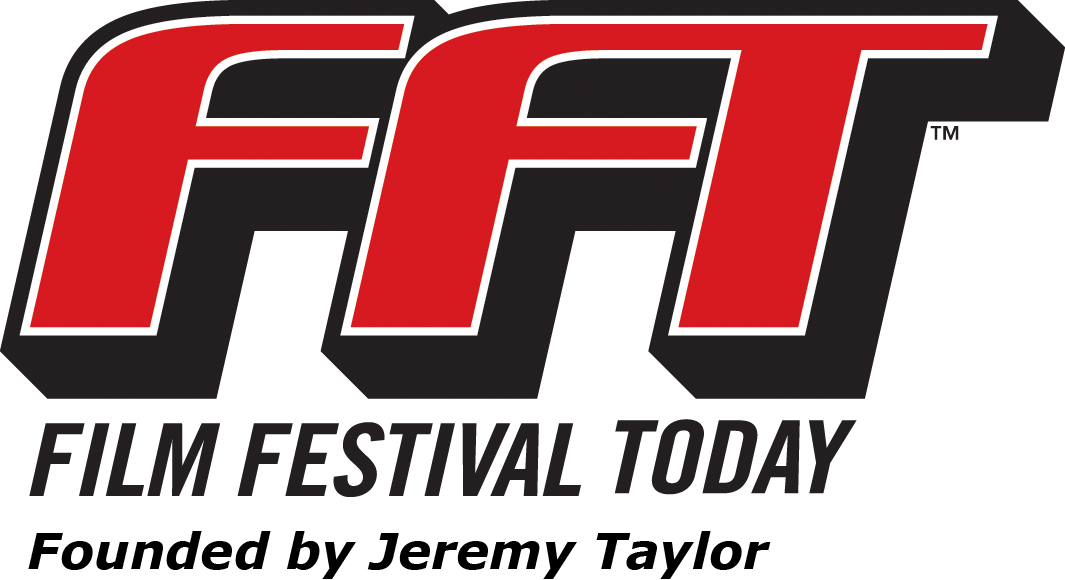TIFF Interview: “Steal Away” Co-Writer Tamara Berger and Director Clement Virgo
Written by: Christopher Llewellyn Reed | September 14th, 2025
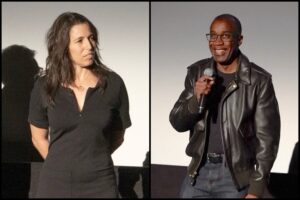
Toronto-based director Clement Virgo just premiered his latest feature, Steal Away, which he co-wrote with wife Tamara Berger, at the 2025 Toronto International Film Festival (where I reviewed it). They previously collaborated on the 2005 Lie with Me. This new project is an adaptation of Karolyn Smardz Frost’s 2017 nonfiction book Steal Away Home and is set in a world that is neither the here nor the now, but possibly both, an amalgam of times and places that are simultaneously familiar and strange. The two central protagonists are Fanny (Angourie Rice, HBO’s Mare of Easttown series) and Cécile (Mallori Johnson, Hulu’s Kindred series), the one white, the other Black and from Africa (Congo). Over the course of the story, they form a bond based on friendship and rivalry, eventually discovering the terrible secret at the heart of their society. A searing condemnation of exploitation and enslavement, the movie becomes a fable that hits far too home in our present-day universe. I spoke to Virgo and Berger by Zoom during the fest, and here is that conversation, edited for length and clarity.
Christopher Llewellyn Reed: Please tell me about Karolyn Smardz Frost’s nonfiction book, Steal Away Home, and how it serves as an inspiration for your movie, Steal Away.
Tamara Berger: I believe the official title is a “nonfiction historical novel.” I don’t know, it’s got a bunch of odd framers for it, but it’s a very, very meticulously researched piece of history about letters that exist between the two main women—who are the inspiration that we took for our movie—taking place in 1830s/1840s Kentucky, during slavery times. It’s basically about their relationship. Cecelia Reynolds was gifted to Fanny Thruston as a personal kind of slave or friend/helper. And the first part of the book really details their strained relationship in the intimate quarters of this very wealthy young white teenager. The book goes on and on and we sort of cut it off at a certain point because we were really mostly interested in their friendship and relationship in this institution of slavery.
Clement Virgo: And for me there was curiosity about that history and love for her book, but at the same time I didn’t really want to make a film about that particular story. I was inspired by it and saw the relevance of what’s happening today, the sense of slavery or the sense of refugees or people who are migrants, people crossing the border. We see that every day now and read about that every day. And so it feels like it has past, present and future elements to it that we wanted to put it into a genre piece.
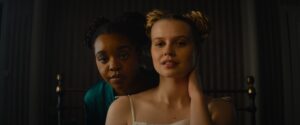
CLR: So your film feels out of time and out of place, in a way. It could be in a bunch of different locations. The time is not specified, but it’s also obviously very specific to various periods of human history and it’s rooted in this time of American slavery. I’m curious about the inclusion of all these French elements, as well.
CV: Well, it’s a Canadian and Belgian co-production, and Belgium has a notorious history within the Congo. So it felt appropriate because we shot it in Belgium and I wanted to make sure that that history, that colonial history, was a part of it. And part of that is language. You see that all over Africa and the Caribbean; Belgium and France and various European countries colonized parts of Africa, Asia, and so forth. So I wanted to speak to that history and make it specific, even though it’s out of time. I wanted this part of the story to be specific to the Congo because again, there’s a violent history that King Leopold had within Belgium, and so it was important that Cécile spoke French, that she spoke Lingala, and that story and that part of the story echoed with some of that history.
CLR: You structure the movie very much as a fable. You even begin with “once upon a time,” and then call it “a tale of two princesses.” And you also have this recurring image of a stag running through the woods. How did you go about making sure that this sense of a fable would be felt throughout the film?
CV: Well, I think fairytales and sci-fi or folk tales free you up a little bit to tell a story in a much more allegorical way. And the stag is a classic image of fairy tales. And one of the films that I love—Blue Velvet, by David Lynch—it opens almost like a fairytale with the beautiful flowers and the white picket fence; you know what I mean? And it’s kind of out of time in that same way where even though it was shot in the ‘80s, we wonder if this is the 1950s, the ‘60s, the ‘70s? Or another film that I love is the horror film It Follows, which is a film that has those same elements. And so it’s a way to kind of smuggle in these ideas. I really wanted to go back to that sense of mythologizing.
The imagery filmed from late 1930s Hollywood films or from the ‘40s and ‘50s had that sort of magical … the images were almost mythical in some ways. And then after the war, with Italian Neorealism and then in the 1960s with cinéma vérité, that changed. But I wanted to really go back to that sense of the theatrical, where the imagery came out of theater in some ways, and that we surrender to a sense that even though it’s not naturalistic or real, there’s a kind of emotional truth that we gravitate to.
TB: I felt like with the writing piece of it, it had to be real to me. Obviously, it goes in so many different directions, but it wasn’t about this kind of cut to imagination, cut to dream. I needed it to be really real.
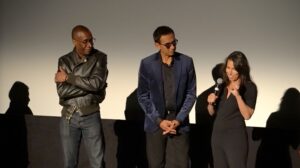
CLR: Clement, you left out the best part of that opening sequence in Blue Velvet, when the camera goes down into the grass and we see the ear …
CV: Right? Yeah, exactly. And David Lynch announces himself with that closeup of the ants in the ear. You’re not in Kansas anymore.
CLR: Very much not. So, you write in the press notes, and mentioned at the Q&A, how you’re inspired in this film by Afrofuturism. What are the elements in the film that you think come directly from this interest in Afrofuturism?
CV: Well, without giving anything away, the way the film sort of climaxes in the forest, I wanted it to echo the past but also imagine a future. One of my favorite images in cinema is at the end of 2001: A Space Odyssey, of a child being born in a sacred time, and that child is symbolic of the future of what’s to come. Thinking about all the children who were born in captivity, who were born on the run, who were born under less-than-ideal circumstances, and echoing that past, but also echoing some of the images that we see today of children being taken away from their parents or in cages. I grew up Christian, I grew up in the church, and one of the stories that I see as a kind of symbolic story is the idea of a child being born in a manger, under a star. So those are mythical stories, fairytale stories, and I wanted that to be a part of it.
CLR: Speaking of that image at the end, I’m curious about the Russian gynecological book that pops up. Did you create that or was that an actual book you found somewhere? And why was it important that it be in Russian?
TB: Well, I think we were hinting that Cécile’s predecessor was Ukrainian, I believe, and so spoke Russian or Ukrainian. But that book was inspired by medical tracks, kind of these weird sexual, erotic medical tracks that exist that kids might find and be like, “Whoa! Look at that.” But no, it was made for the film.
CV: Tamara was on set every day, so I would ask her to make sure that this book, this prop, worked. But you take things from around you as a filmmaker through osmosis, and the Ukraine War was happening, and for me, the film is about the present, even though it’s set out of time. It’s about what is happening around the world.
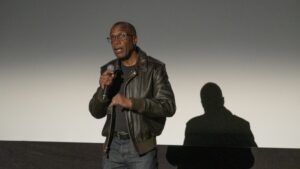
CLR: So, let’s talk about the casting. You have two leads, Angourie Rice and Mallori Johnson. How did you find them, as well as some of the other cast, as well?
TB: Well, Mallori was in Kindred, and I love that book. And I thought the series was really great, too. And we saw her tape, and it was kind of in the middle of casting. We’d seen lots of young actors, but I just right away felt that she was incredible. And then meeting her just sort of kept it all going. She’s Juilliard-trained and is just incredible.
CV: I remember when Tamara saw the tape, she called me and said, “Did you see her, Mallori?” And I said, “Yeah. Outstanding.” Angourie is an actress that I’ve followed. And she auditioned and I just love the way she spoke about the character. And she’s very, very smart, with this kind of innocence and effervescent quality. And of course, it’s all about their chemistry, as in tons of films.
CLR: And how about the others, like the mothers?
CV: Well, for Lauren Lee Smith, Tamara and I, 20 years ago …
CLR: That’s right, she was in your Lie with Me …
CV: She was the star of Lie with Me. That’s right. And I’ve worked with her in television over the years, and I first met her on The L Word when I was a director-for-hire, and then subsequent TV shows. And Idrissa [Sanogo Bamba], he’s such a beautiful young specimen. He has a kind of matinee-idol quality that I love. And then, because it’s a Belgian co-production, we looked across Europe for all the actors we could find.
CLR: Speaking of Idrissa, at times in the film he looks like this sort of classic hunk who could be an object of desire for the girls. But in the scene where he’s dancing in that initial seduction, he also looks like such a young person. And that’s so important, I think, because he’s also being used by the system and exploited. And I really liked that scene because suddenly his face looks just much, much younger. Could you talk about that scene?
CV: I’m really glad you liked that scene because it was so spontaneous; we made it up on the spot in a weird way. Our son was working on a film, and I was looking for a song and my son said, “You should use this song.” And he’s 18 years old, a little bit younger than Idrissa. And I told Idrissa, “Dance, but don’t dance well.” And he just kind of made up that choreography on the spot, and all of Mallori’s reactions were real, and I just wanted it to be sort of playful, young love and just kind of freed up, because a lot of the film is very controlled. But that one, I went with a looser handheld feel just to give the young performance free reign to be in the moment.
TB: And I don’t know if you were there on Friday at the premiere, but …
CLR: No, I went to the Saturday screening.
TB: Someone asked a question about the father-son relationship, and why didn’t we get more of the father-son relationship? And I mean, I don’t even know if I’ll be able to paraphrase it, but Idrissa just spoke so beautifully about the son not being close to his father and not wanting to repeat that cycle in his own emerging adulthood. Anyway, he just spoke really uniquely and beautifully about it.
CLR: I think he does a great job, as does the rest of your cast. Thank you so much for chatting with me.
TB: Thank you!
CV: Thank you!
